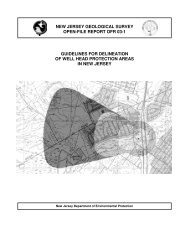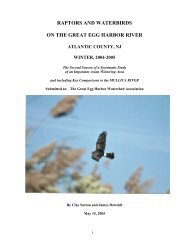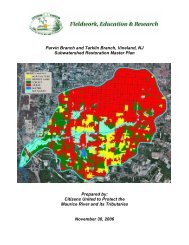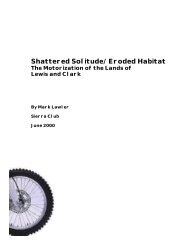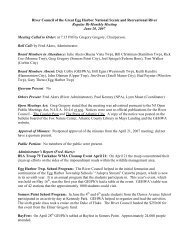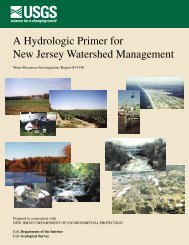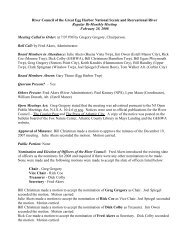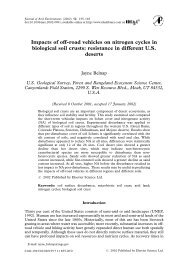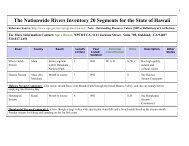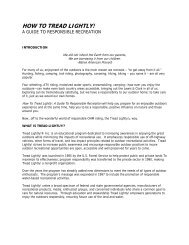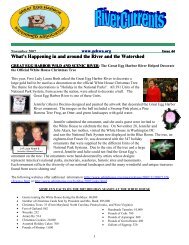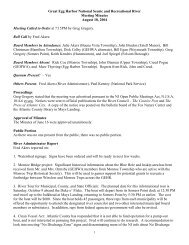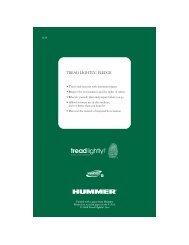May - Great Egg Harbor Watershed Association
May - Great Egg Harbor Watershed Association
May - Great Egg Harbor Watershed Association
You also want an ePaper? Increase the reach of your titles
YUMPU automatically turns print PDFs into web optimized ePapers that Google loves.
<strong>May</strong> 2007 www.gehwa.org Issue 42<br />
What’s Happening in and around the River and the <strong>Watershed</strong><br />
GREAT EGG HARBOR WATERSHED ASSOCIATION: On <strong>May</strong> 22, 2007, the <strong>Great</strong> <strong>Egg</strong> <strong>Harbor</strong><br />
<strong>Watershed</strong> <strong>Association</strong> proudly presented the 1 st<br />
annual award of $500.00 from the Belinda Irizarry<br />
Memorial Fund to Victoria Schmidt. Belinda<br />
devoted her life to saving the natural habitat and<br />
caring for neglected and abandoned animals, so it<br />
is only fitting that the first award should go to<br />
someone whose life mission is similar to<br />
Belinda’s. Professionally, Victoria has worked for<br />
the past 29 years as a Respiratory Therapist. She<br />
currently works for South Jersey Healthcare. Her<br />
job financially enables her to pursue her passion of<br />
caring for wounded and abandoned animals, which<br />
she has done for the past twenty-three years.<br />
Victoria is a New Jersey state licensed Wildlife<br />
R > L: Sarah Summerville, GEHWA<br />
Trustee presented Victoria Schmidt, wildlife<br />
rehabilitator with the award.<br />
Rehabilitator. She uses her personal funds to<br />
maintain her animal care facility on 12 acres in<br />
Barnsboro. Her rehabilitation work is not supported by<br />
any agency or organization. She is certified to care for<br />
opossum, rabbit, fox, raccoon, skunk, and squirrels, though at times she has gotten approval to handle other<br />
species. Victoria has had a high success rate for recovery and release.<br />
Victoria has released rehabilitated fox and raccoon at the Unexpected Wildlife<br />
Refuge in Buena Vista Township. She also transports wounded and<br />
abandoned birds to the Tri-State Bird Rescue in Newark, Delaware and is a<br />
member of their oil spill response team. She gives credit to her mother for the<br />
example her mom set while Victoria<br />
was growing up. “My mom’s<br />
compassion for sick and injured<br />
wildlife had a tremendous influence on<br />
what I do today.” Thank you, Victoria,<br />
for all that you do and a special thanks<br />
to all who have made, and continue to<br />
make contributions to the Belinda<br />
Irizarry Memorial Fund. (For more<br />
Belinda Irizarry<br />
information about Victoria see<br />
“Member Meetings” below)<br />
Baby Woodcocks<br />
1
FOLSOM BORO: The Folsom<br />
Environmental Committee (EC)<br />
presented their “Environmental<br />
Pledge Program” at Folsom School<br />
on April 20 th , as an Earth Day<br />
project. The 1 st and 2 nd grade<br />
students were asked to sign a<br />
pledge<br />
as a<br />
friend<br />
Folsom 1 st and 2 nd Graders and their<br />
Teachers<br />
to the rivers, earth, sky and all the animals, requesting that they will: pick-up trash,<br />
recycle, not liter, etc. In the photo above, the students are wearing their “Freddy<br />
Folsom” tee-shirts. All of the students are given a tee-shirt when they sign the<br />
pledge. Belinda Irizarry started the program about 10 years ago and the Folsom<br />
EC continues to present it every two years.<br />
MONROE TOWNSHIP: On March 13 th and 14 th GEHWA could be found in Paul VanHouten’s 6 th grade<br />
science class at Williamstown Middle School. The<br />
first day the students were taught “What is a<br />
<strong>Watershed</strong>” and how stormwater runoff contributes<br />
to water pollution. By using a video clip of the path<br />
of an animated raindrop (the kids loved the raindrop)<br />
and the EnviroScape Stormwater Model, students<br />
gained an understanding that their actions have an<br />
impact on water quality. Since litter was a topic at a<br />
recent GEHWA trustee meeting, students were asked<br />
if they throw trash on the ground. They were very<br />
honest, and the majority replied, “Yes”. The first day<br />
students were challenged to do two things to help<br />
clean up pollutants found in stormwater runoff and,<br />
in turn, help the environment. 1. Don't litter and<br />
pick up trash and, 2. Pick up your animal's waste.<br />
On the second day, using a video clip on<br />
groundwater and the Groundwater Model (the students were very interested in the Groundwater Model), the<br />
students learned “Where Does Your Water Come From?”. They also learned that their water usage can have an<br />
impact on the water supply. The students were challenged on the second day to reduce their daily water<br />
consumption. By connecting excess consumption to the additional energy required to provide for their water<br />
needs, the students gained a new awareness that it requires the burning of fossil fuels to supply the energy<br />
needed to pump their water. This in turn led to a discussion on how excessive water consumption results in<br />
greater greenhouse gas emissions. (Many of the students admitted to taking hour-long showers, much to their<br />
teacher’s horror.)<br />
TUCKAHOE: Once again, BSA Troop 79 was busy<br />
picking up trash. The last clean-up the troop participated in<br />
was on the Tuckahoe River in September. On April 21 st they<br />
concentrated their efforts on the roadsides of the Tuckahoe<br />
Wildlife Management Area (WMA). The day started out<br />
sunny but chilly. Some of the scouts, anticipating a warm<br />
day, arrived wearing only tee shirts and shorts! Many bags<br />
of trash were collected, along with tires, a boat and other<br />
2
debris. It quickly became apparent that the majority of the beverage containers collected were of the alcoholic<br />
variety. Since it is illegal to carry an open alcoholic beverage container in a vehicle, the easiest method of<br />
disposal is to toss it out the window to become part of the roadside flora.<br />
<strong>May</strong>be folks who must complete community service due to a DWI<br />
conviction should be made to participate in a roadside clean-up. After a<br />
day picking up bottles and cans containing stale beer, and having those<br />
same smelly contents spill on their clothing, it might have an impact on<br />
their future drinking and driving habits. Due to time limitations and the<br />
extent of the roads in the WMA, the clean-up crew was not able to get to<br />
all of the roadside trash.<br />
The day also offered some excitement that had nothing to do with trash.<br />
We found time to play peek-a-boo with the ground bee (shown in the<br />
photo at right).<br />
RICHARD STOCKTON COLLEGE: GEHWA continues to support programs at Stockton. In March, Fred<br />
Akers taught the students in Jamie Cromartie’s Ecological<br />
Principles class about the vernal ponds that can be found on the<br />
campus. Water chemistry analysis was done. Stick samples<br />
were collected to check for macroinvertebrates. Some of the<br />
students from the class, as well as faculty from the school, also<br />
participated in evening “Frog Walks” led by “<strong>Watershed</strong> Fred”<br />
(3/22 and 3/26/2007) to four vernal ponds on campus.<br />
Jack Connor, a Stockton<br />
professor who participated in<br />
the walks, recorded the<br />
following data: peepers<br />
calling in 100s, possibly<br />
1000s, and chorus frogs calling in dozens on the humid and warm (high<br />
50s/low 60s?) night of 3/22; peepers, chorus frogs, and southern leopard<br />
frogs calling on the cooler (low 40s?) night of 3/26 – in somewhat lower<br />
numbers. Peepers were calling at all four ponds visited. Professor Connor<br />
also took some interesting photos that can be viewed at the following web<br />
address: http://nacotejack.smugmug.com/gallery/2619334/2/139023759. If<br />
you would like to learn some frog calls, go to the following web address: http://www.nwf.org/frogwatchUSA.<br />
GREAT EGG HARBOR WATERSHED AND<br />
NEIGHBORS: During the months of April and <strong>May</strong>,<br />
GEHWA tabled in: Atlantic County at the ACUA’s Earth<br />
Day and at the Hamilton Mall for the county’s “Government<br />
Week”; <strong>Egg</strong> <strong>Harbor</strong> Township School’s jamboree for their<br />
“Catawba Project”; Somers Point at their Bayfest; and<br />
Cumberland County at the Wheaton Arts Eco-Fair. At these<br />
events educational materials on stormwater runoff and water<br />
conservation were handed out and the Groundwater Model<br />
was used to demonstrate where drinking water comes from.<br />
Apparel and toy items (proceeds from the sale of toys go to<br />
the Belinda Irizarry Memorial Fund) were sold, and several<br />
folks became new members of GEHWA.<br />
3
Where’s the<br />
Flooding?<br />
<strong>Watershed</strong> Degradation Also Means More Flooding<br />
By: Fred Akers<br />
As our watershed becomes more developed and paved over, the natural hydrology is altered<br />
and usually degraded. In an undisturbed coastal plain watershed, over 90% of the rainwater<br />
River Administrators Desk from a storm, soaks (infiltrates) into the forest and wetlands. This process of infiltration<br />
helps filter pollutants from the water, recharge aquifers, and provides a continuous base<br />
flow to rivers and streams. These functions are all natural ecosystem services that are both free and vital to a healthy<br />
environment.<br />
Roads, driveways, sidewalks, rooftops, compacted soils and other impervious surfaces resulting from development, block<br />
the natural infiltration of stormwater, and cause large quantities of stormwater to runoff over these impervious surfaces<br />
into rivers and streams. The runoff transports chemical, sediment, and trash pollution to the nearest waterbody. It can<br />
also cause physical changes to stream size and shape, and damage and destroy sensitive aquatic habitats. It also reduces<br />
aquifer recharge and stream base flow. It can cause flash flooding that can take both lives and property.<br />
On April 15 and 16 of this year, a storm came through from the northeast and dumped 2.66 inches of rain at the Atlantic<br />
City Airport in Pomona, 4.75 inches at the USGS Gauging Station in Folsom, 5.82 inches at the Mount Holly Weather<br />
Station, and 5.05 inches at the Philadelphia Airport. Though the rain stopped on April 16 and less than 3 inches fell in the<br />
eastern part of Atlantic County, the <strong>Great</strong> <strong>Egg</strong> <strong>Harbor</strong> River above and below Weymouth began to flood on April 17, and<br />
crested early Wednesday morning on April 18. This flooding event was the worst I can recall. The USGS gauging station<br />
at Folsom recorded the water height at 2 feet above flood stage. Flow at the gauging station is generally measured at 100<br />
cubic feet per second (cfs). Flow at flood stage was measured at 1000 cfs. The flood damage was significant. Homes<br />
were inundated, and roads and other structures were damaged. When the total cost of all the damages was finally<br />
estimated, Atlantic County was designated as an official disaster area and qualified for Federal Emergency Management<br />
Agency (FEMA) financial aid.<br />
Given the fact that more rain fell to the west of Weymouth, the almost 2 day delay between the rain and the flooding at<br />
Weymouth, and the fact that the western portions of the watershed in Gloucester and Camden counties have some of the<br />
most developed areas in the watershed, I began to wonder if this flooding in the eastern portion of the watershed was an<br />
indication of growing urban stormwater management problems upstream of Weymouth. With an overall area of 600<br />
square miles in the <strong>Great</strong> <strong>Egg</strong> <strong>Harbor</strong> <strong>Watershed</strong>, it is not a simple matter to identify all of the possible stormwater<br />
sources that would create a cumulative flooding impact down stream, or to recommend what tools to use to protect the<br />
watershed.<br />
NJDEP 2002 land use data shows that over 66,000 acres of the 377,000 acres of the <strong>Great</strong> <strong>Egg</strong> <strong>Harbor</strong> <strong>Watershed</strong>, or<br />
about 17.5%, have been converted from natural lands to urban lands, 13,000 of those acres since 1986. Coincident to this<br />
increasing urbanization of the watershed, a number of dams in the watershed have been flagged by NJDEP to be either<br />
strengthened or decommissioned as a result of the increasing volume of stormwater runoff. As the percentage of<br />
impervious surfaces increases, stormwater runoff also increases, leading to flash flooding.<br />
The <strong>Great</strong> <strong>Egg</strong> <strong>Harbor</strong> <strong>Watershed</strong> <strong>Association</strong>’s Geographical Information Systems (GIS) department has been working<br />
on watershed land use analysis for several years now, with the goal of eventually analyzing all of the land use changes and<br />
trends for the entire watershed. Given the seriousness of the flooding in places like Hamilton Township in Atlantic<br />
County, GEHWA is working to identify the extent of impervious surfaces and stormwater discharges within the <strong>Great</strong><br />
<strong>Egg</strong> <strong>Harbor</strong> <strong>Watershed</strong>. This updated land use analysis will help us to provide information to local and county agencies<br />
about the local and downstream impacts of stormwater runoff. Our goal is to provide local communities with a realistic<br />
approach for maintaining a quality environment within the watershed for future generations.<br />
**Member Meetings**<br />
“What’s in Our Backyard”<br />
The original movie “Protecting Our Waters –The <strong>Great</strong> <strong>Egg</strong> <strong>Harbor</strong> River and <strong>Watershed</strong>,” which captured the<br />
natural beauty, historical and cultural resources, and threats to our river was first produced in video format, but is now<br />
4
available in DVD format. The DVD version, complete with separate chapters, was premiered on Tuesday, March 27 at<br />
the Members Meeting. Newer members were delighted to learn of the historical, ecological and recreational aspects of<br />
the river, while older members shared memories of the river. In addition, there was discussion on protection of the river:<br />
past, present and future.<br />
At the <strong>May</strong> 22 nd members meeting, Victoria Schmidt, recipient of the 1 st annual award from the Belinda Irizarry Memorial<br />
Fund, presented a slide show of animals that she has either rehabilitated<br />
or had a part in their rehabilitation. She shared stories of her many<br />
triumphs and occasional losses. Victoria warned viewers not to assume<br />
that a baby animal has been<br />
abandoned, and told them<br />
what to look for before<br />
inadvertently “rescuing” an<br />
animal that does not need to<br />
be rescued. She used a fawn<br />
as an example. A doe will<br />
Raccoon<br />
constantly groom a fawn to<br />
control parasites. If you<br />
encounter a fawn that appears abandoned, check to see if it is infested with<br />
parasites (i.e. ticks). If it is not, leave it alone, as there is likely a mother<br />
caring for it.<br />
If you would like to support Victoria’s mission, the following are ways in which you can assist:<br />
Donations are always welcome, including PetSmart gift cards (for the purchase of wildlife formula) and<br />
cages, crates or hutches. Please feel free to contact Vicky, who is a New Jersey, state licensed Wildlife<br />
Rehabilitator, with your questions or help with injured wildlife.<br />
Victoria Schmidt<br />
115 Heritage Road<br />
Barnsboro, NJ 08080<br />
856-468-1484<br />
SPECIAL NOTE: If you encounter an animal that has been wounded or abandoned you can either contact the Division<br />
of Fish and Wildlife at 609-292-2965 or check online to find a list of NJ Wildlife Rehabilitators by Species at<br />
http://www.njfishandwildlife.com/rehablst.htm .<br />
New Jersey has strict laws governing the possession of wild animals, including those injured or orphaned.<br />
Most times, what appears to be orphaned young wildlife is not and the best thing to do is leave the animal<br />
where it is found. Handling wildlife can be harmful to the animal and possibly to the person handling it.<br />
Generally, unless it is known that the mother has been killed or injured, the public is urged to leave young<br />
wildlife alone. The parent will do its best to care for it. A baby bird can be placed in a shrub to help protect it<br />
from predators, but the adult(s) will protect and feed it. It is a myth that, once handled, the human scent will<br />
keep the parent away; songbirds do not have a sense of smell!<br />
Fox<br />
What you can do!<br />
As science continues to provide growing evidence of “Global Warming”, humans are faced with making<br />
choices. Ignore the evidence, acknowledge the problem but make no lifestyle changes, or acknowledge the<br />
problem and make a conscious effort to change your impact on the earth. The various colors on the maps<br />
shown below are used to denote differing temperatures. Zones 2 thru 10 denote the coldest expected<br />
temperatures for that specific area of the United States. Differences between 1990 USDA hardiness zones<br />
and 2006 arborday.org hardiness zones represent changes in the coldest expected temperatures throughout<br />
the United States. On the 1990 map, NJ was predominantly in Zone 6, with the lowest temperatures ranging<br />
from:-23 to -18 C (-10 to 0 F). The 2006 map shows NJ as predominantly in Zone 7, which shows a decrease<br />
in lowest temperatures: -18 to -12 C (0 to 10 F). Over time, changes in temperature will have an impact on<br />
what will grow in an area. This change will also have an impact on animal life. The result may be the loss of<br />
5
oth plant and animal species in an area as they migrate to a more favorable climate or extinction due to<br />
restrictions on their migration or ability to adapt.<br />
One of the simplest ways of making a lifestyle change is to swap an incandescent light bulb with a compact<br />
fluorescent bulb. If every American home replaced just one light bulb with an ENERGY STAR qualified bulb,<br />
we would save enough energy to light more than 3 million homes for a year, more than $600 million in<br />
annual energy costs, and prevent greenhouse gases equivalent to the emissions of more than 800,000 cars<br />
(U.S. Environmental Protection Agency – U.S. Department of Energy,<br />
http://www.energystar.gov/index.cfm?c=cfls.pr_cfls).<br />
The table to the left<br />
makes a comparison<br />
between compact<br />
fluorescent bulbs<br />
(CFL) and<br />
incandescent bulbs.<br />
Eight incandescent<br />
bulbs would be<br />
needed to equal the<br />
lifespan of one CFL.<br />
Based on the data<br />
provided, replacing<br />
one CFL would equal<br />
a savings of<br />
approximately<br />
$25.00 over its<br />
lifespan. If several<br />
CFLs were replaced<br />
the savings could be<br />
considerable, not just<br />
financially but<br />
environmentally as<br />
well.<br />
6
<strong>Great</strong> <strong>Egg</strong> <strong>Harbor</strong> <strong>Watershed</strong> <strong>Association</strong><br />
Julie Akers, President (856) 697-6114<br />
Fred Akers, Administrator (856) 697-6114<br />
P. O. Box 109; Newtonville, NJ 08346<br />
Email: fred_akers@gehwa.org<br />
Web Site: www.gehwa.org<br />
Lynn Maun, Coordinator (856) 453-0416<br />
Email: lynnkmaun@comcast.net<br />
National Park Service<br />
Paul Kenney (215) 597-5823<br />
Paul_Kenney@nps.gov<br />
NJDEP <strong>Watershed</strong> Management Office<br />
Robert Mancini (609) 777-0580<br />
Atlantic County Department of Planning<br />
Bob Lindaw (609) 645-5898<br />
US Army Corps of Engineers (215) 656-6725<br />
NJDEP Regulatory Office for Atlantic County<br />
(609) 292-8262<br />
NJDEP Enforcement Officer<br />
Kevin Brown (732) 255-0787<br />
Pinelands Commission<br />
Main Number (609) 894-7300<br />
NJDEP Hotline: 1-877 WARN DEP<br />
Wednesday, June 20, 2007<br />
<strong>Great</strong> <strong>Egg</strong> <strong>Harbor</strong> NS & R River Council Meeting<br />
Calendar of Events<br />
Tuesday, September 25, 2007<br />
GEHWA Members Meeting<br />
Tuesday, July 24, 2007<br />
GEHWA Members Meeting (See Notice in Newsletter)<br />
Saturday, August 4, 2007<br />
Pinelands Folk Art Festival<br />
Wednesday, August 15, 2007<br />
<strong>Great</strong> <strong>Egg</strong> <strong>Harbor</strong> NS & R River Council Meeting<br />
Wednesday, October 17, 2007<br />
<strong>Great</strong> <strong>Egg</strong> <strong>Harbor</strong> NS & R River Council Meeting<br />
Tuesday, November 27, 2007<br />
GEHWA Members Meeting<br />
Wednesday, December 19, 2007<br />
<strong>Great</strong> <strong>Egg</strong> <strong>Harbor</strong> NS & R River Council Meeting<br />
Membership Information<br />
Your membership supports our mission and ensures our survival as a non-profit advocate, as we work to protect<br />
and preserve the <strong>Great</strong> <strong>Egg</strong> <strong>Harbor</strong> River and <strong>Watershed</strong> throughout the year. As a result of federal budget cuts,<br />
your support is needed now more then ever. Without you, we could not exist. Thank you for your support!<br />
Name/Organization: ___________________________________________________________________<br />
Street Address: ___________________________________________________________________<br />
City, State, and Zip: ___________________________________________________________________<br />
Phone Number: ___________________________________________________________________<br />
Email address: ___________________________________________________________________<br />
_____ Yes, I would like to receive notices by Email.<br />
Annual Membership: Individual: $10; Family: $15; Supporting: $35; Patron: $50; Corporate: $100<br />
Please mail this form along with your check to:<br />
<strong>Great</strong> <strong>Egg</strong> <strong>Harbor</strong> <strong>Watershed</strong> <strong>Association</strong>, Membership, P.O. Box 109, Newtonville, NJ 08346<br />
7
Newsletter from the <strong>Great</strong> <strong>Egg</strong> <strong>Harbor</strong> <strong>Watershed</strong><br />
<strong>Great</strong> <strong>Egg</strong> <strong>Harbor</strong> <strong>Watershed</strong> <strong>Association</strong><br />
P.O. Box 109<br />
Newtonville, NJ 08346<br />
8



